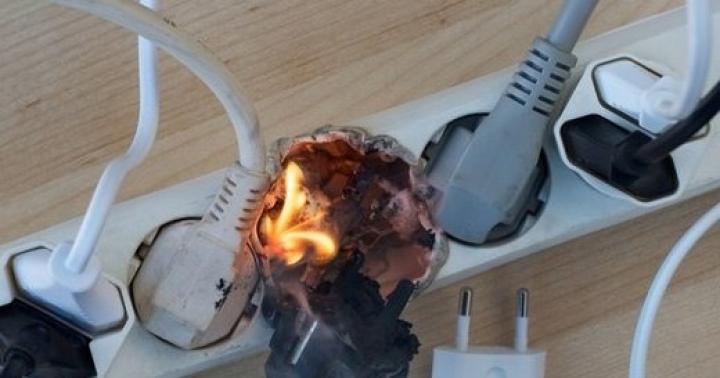Last night I landed at Sheremetyevo and once again observed the procedures for turning off the lights during takeoff and landing. Maybe I guessed the reasons for these manipulations, but I still decided to test myself and look for the answer on the Internet. And you know, there is no consensus there.
They offer at least two options, but it seems that only one is correct:

The first option is:
The fact is that the entire aircraft consumes electricity from only one source - the generator. Two consequences follow.
Since the generator withstands enormous loads during takeoff and landing, it is very important that nothing unnecessary consumes energy at this moment. A few seconds during takeoff and a few during landing are nothing compared to the energy saved for operating the hydraulic cylinders.
Every additional electrical consumption during takeoff and landing is a possibility of a short circuit or even a fire. Therefore, out of harm’s way, it’s better not to work for a couple of seconds.

The second option can be paraphrased like this:
The lights in the cabin are turned off in order to determine the presence of fire on the left or right side of the aircraft in the event of an emergency during landing or a forced landing. This procedure is not for passengers, but for flight attendants, so if a fire is detected on the left, evacuation will be carried out to the right and vice versa.
Natural light also helps passengers’ eyes get used to and react correctly to emergency situations that may arise during landing or takeoff.
So again: curtains and turning off the lights allow passengers' eyes to adapt to external lighting, and so that the cabin crew can see their surroundings in the event of an emergency when evacuation is necessary.
RESULT:
As experts write, turning off the lights for the sake of safety of the electrical network and reducing the load may have been true in very old aircraft. In modern aircraft, there is absolutely no need to turn anything off for this purpose. Moreover, passengers can use personal lighting and there is a possibility that all passengers will turn it on.
Therefore, as far as I understand, the second option is the only correct one. Right?
Taking off and landing on the runway are the two most dangerous moments in the entire flight. It is during takeoff and landing that most aircraft accidents occur. A plane rarely crashes when it loses control at high altitude or gets into a turbulent zone - usually this is “nothing” for pilots. What is really responsible and difficult is to take off and land.
It is for this reason that special attention is paid to environmental factors during takeoff and landing. Namely:
1) Passengers must be wearing seat belts and cannot leave their seats during this period of time
2) The window shades must be raised
3) The light must be turned off
We will examine the first two points briefly, and then we will consider Why do the lights on airplanes turn off during takeoff and landing?.
So, on the first point. Passengers should sit in their seats and not stand up, as jolts are possible during emergency braking, which can result in injury if safety rules are not followed.
Attention!
Respect the work of the stewards! When you sit unfastened or try to get up to get things from your hand luggage, go to the toilet or just walk around, you violate safety regulations and force the stewards to come up to you to ask you to sit down and buckle up. Thus, the stewards risk their health by walking around the cabin at full height while braking.
Regarding the curtains, they are then raised so that passengers from the inside can assess the situation outside, and from the outside, the situation inside. If, in the event of an accident during sudden braking, something happens to the interior, it will be easier for rescuers to look inside and determine what to do.
Why do the lights turn off on an airplane during takeoff and landing?
The fact is that the entire aircraft consumes electricity from only one source - the generator. Two consequences follow.
Since the generator withstands enormous loads during takeoff and landing, it is very important that nothing unnecessary consumes energy at this moment. A few seconds during takeoff and a few during landing are nothing compared to the energy saved for operating the hydraulic cylinders.
Every additional power consumption during takeoff and landing is a possibility of a short circuit or even a fire. Therefore, out of harm’s way, it’s better not to work for a couple of seconds.
So, now you know all the secrets of an airplane during takeoff and landing.
Even if you fly on airplanes quite often, I don’t think you’ve ever thought about the purpose of turning off the lights on board an airplane during takeoff and landing.
As it turns out, there are several reasons for such a blackout in aircraft cabins.
2

Option one: The plane consumes electricity exclusively from the generator. It follows from this that due to the colossal loads on the generator at the time of takeoff and landing, there should be no additional sources of energy consumption.
Turning off the lights in the cabin eliminates the operation of additional sources of consumption. This helps prevent short circuits and fires.
3

Option two: The procedure for turning off the lights in the cabin is necessary for flight attendants. If an emergency situation arises during a forced landing or landing, it is necessary to identify a possible fire on the right or left side. In this case, a decision will be made on which side it is necessary to evacuate people. Plus, the eyes of passengers will get used to natural light, and then in the event of an emergency, people will be able to evacuate urgently.
4

5

To summarize: In older aircraft, it made sense to turn off the cabin lights to reduce load. However, on modern aircraft, passengers can even use personal lighting, and there is no need to turn off cabin lighting to save energy.
Based on this, the second option is the only correct one. What do you think?
If you've flown on an airplane, you know that during takeoff and landing, the lights in the cabin go out. Have you ever wondered why this is needed?
Of course, this has nothing to do with increasing the drama of such important moments as takeoff or landing. Chris Cook, a long-time pilot, explains that this is for safety reasons. Temporarily turning off the lights allows passengers' eyes to adjust to the darkness in case of an emergency.

It is known that the periods of landing and takeoff are the most dangerous, and it is at these moments that plane crashes most often occur. In the event that passengers require emergency evacuation, passengers who are previously accustomed to the darkness will be able to quickly find their bearings.
On average, a person needs about 10 minutes of time for his eyes to adjust to the dark. Therefore, this security measure saves valuable time. In addition, the darkness on board is not pitch black. When the lights are turned off, emergency entrances and exits, as well as escape routes, continue to be illuminated. This gives passengers time to look around and, in the event of an emergency, quickly find their bearings.

By the way, for the same reason, during landing, the window curtains are opened so that in case of an emergency, daylight can illuminate the interior.
Based on materials:
You can add a few more to this requirement: raise the window shades, bring the chairs to an upright position and turn off the overhead lamp.
The reasons are as follows:
1. The likelihood that the engine under the wing will catch fire is highest during takeoff and landing. We, the passengers, play an important role here - the pilots rely on our eyes, ears and what we will report if we notice signs of fire (after all, passengers will see them first). The lights in the cabin are turned off to make it easier to see.
2. Of course, your eyes need to get used to the bright light (or darkness) outside in the event of an emergency landing. In addition, the illumination of the path to the emergency exit will be better visible.
3. The curtains must be raised so that the condition of the aircraft can be assessed. In this case, passengers will be visible from the outside. This is important if a plane is suspected of being hijacked - it is important for rescue services to see what is happening inside the cabin.
4. The curtains must be raised during takeoff also in case the plane flies into closed airspace. Then a military plane can fly up and see what's going on inside. There was once a case in Europe where a passenger plane was found in a restricted area. Then the interceptor plane was able to see that the passengers in the cabin and the pilot were sleeping. That plane eventually crashed, but thanks to the raised curtains, it was clear that the cause of the disaster was a problem with the oxygen supply (it is unknown why), and not hijacking or pilot error.
5. The seats are brought to a vertical position so as not to lose valuable seconds in an emergency.
These rules have evolved over the years of development of commercial aviation and are observed almost throughout the world.


